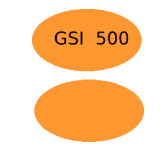Uses
Ranolazine is used alone or with other medications to treat chronic angina (ongoing chest pain or pressure that is felt when the heart does not get enough oxygen). Ranolazine is in a class of medications called anti-anginals. The exact way that ranolazine works are not known at this time.
Side Effects Of Ranolazine
Ranolazine may cause side effects. Tell your doctor if any of these symptoms are severe or do not go away:
- nausea
- constipation
- headache
- dizziness
Some side effects can be serious. If you experience any of these symptoms, call your doctor immediately:
- fast, pounding, or irregular heartbeat
- difficulty breathing
- fainting
Ranolazine may cause other side effects. Call your doctor if you have any unusual problems while you are taking this medication.
Warnings & Precautions
Before taking ranolazine:
- tell your doctor and pharmacist if you are allergic to ranolazine, any other medications, or any of the ingredients in ranolazine extended-release tablets. Ask your pharmacist for a list of the ingredients.
- tell your doctor if you are taking any of the following medications: antifungals such as itraconazole (Onmel, Sporanox) and ketoconazole (Nizoral); clarithromycin (Biaxin, in Prevpac); medications to treat human immunodeficiency virus (HIV) or acquired immunodeficiency syndrome (AIDS) such as indinavir (Crixivan), lopinavir and ritonavir (Kaletra); nelfinavir (Viracept), ritonavir (Norvir, in Kaletra, in Viekira Pak, others), and saquinavir (Invirase); nefazodone; medications for seizures such as carbamazepine (Carbatrol, Equetro, Tegretol, others), phenobarbital, and phenytoin (Dilantin, Phenytek); rifabutin (Mycobutin); rifampin (Rifadin, Rimactane, in Rifamate, in Rifater); and rifapentin (Priftin). Also, tell your doctor if you are taking St. John’s wort. Your doctor may tell you not to take ranolazine if you are taking one or more of these medications or herbal products.
- tell your doctor and pharmacist what other prescription and nonprescription medications, vitamins, nutritional supplements, and herbal products you are taking or plan to take. Be sure to mention any of the following: amiodarone (Cordarone, Nexterone, Pacerone); antidepressants such as amitriptyline, clomipramine (Anafranil), and desipramine (Norpramin); and imipramine (Tofranil); medications to treat high cholesterol such as atorvastatin (Lipitor, in Caduet), lovastatin (Altoprev, in Advicor), and simvastatin (Zocor, in Simcor, in Vytorin); cyclosporine (Gengraf, Neoral, Sandimmune); digoxin (Lanoxin); diltiazem (Cardizem, Dilacor, Tiazac, others); dofetilide; (Tikosyn); erythromycin (E.E.S., Erythrocin, PCE); fluconazole (Diflucan); medications for mental illness such as haloperidol (Haldol), risperidone (Risperdal), thioridazine, and ziprasidone (Geodon); metformin (Fortamet, Glumetza, in Glucovance, others); quinidine (in Nuedexta); sirolimus (Rapamune); sotalol (Betapace, Sorine); tacrolimus (Astagraf, Envarsus XR, Prograf); and verapamil (Calan, Covera, Verelan, others). Your doctor may need to change the doses of your medications or monitor you carefully for side effects. Many other medications may also interact with ranolazine, so be sure to tell your doctor about all the medications you are taking, even those that do not appear on this list or the list above.
- tell your doctor if you have or have ever had liver disease. Your doctor may tell you that you should not take ranolazine.
- tell your doctor if you or anyone in your family has or has ever had a prolonged QT interval (a rare heart problem that may cause fainting or irregular heartbeat) or a fast, slow, or irregular heartbeat. Also tell your doctor if you have or have ever had an abnormal electrocardiogram (ECG: a test that records the electrical activity of the heart), low levels of potassium in the blood, or kidney disease.
- tell your doctor if you are pregnant, plan to become pregnant, or are breastfeeding. If you become pregnant while taking ranolazine, call your doctor.
- you should know that ranolazine may make you dizzy and lightheaded. Do not drive a car, operate machinery, or participate in activities requiring mental alertness and coordination until you know how this medication affects you.
Dosage Of Ranolazine
Ranolazine comes as an extended-release (long-acting) tablet to take by mouth. It is usually taken with or without food twice daily. Take ranolazine at around the same times every day. Follow the directions on your prescription label carefully, and ask your doctor or pharmacist to explain any part you do not understand. Take ranolazine exactly as directed. Do not take more or less of it or take it more often than prescribed by your doctor.
Swallow the tablets whole; do not break, chew, or crush them.
Your doctor will probably start you on a low dose of ranolazine and gradually increase your dose.
Do not take ranolazine to treat a sudden attack of angina. Your doctor will tell you what you should do if you experience an attack of angina. Make sure that you understand these directions.
Ranolazine may help control your condition but will not cure it. Continue to take ranolazine even if you feel well. Do not stop taking ranolazine without talking to your doctor.
Ask your pharmacist or doctor for a copy of the manufacturer’s information for the patient.
Other
Keep all appointments with your doctor.
Do not let anyone else take your medication. Ask your pharmacist any questions you have about refilling your prescription.
It is important for you to keep a written list of all of the prescription and nonprescription (over-the-counter) medicines you are taking, as well as any products such as vitamins, minerals, or other dietary supplements. You should bring this list with you each time you visit a doctor or if you are admitted to a hospital. It is also important information to carry with you in case of emergencies.
Source
All information has been provided courtesy of MedLinePlus from the National Library of Medicine and from the FDA.



